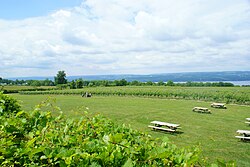| Wine region | |
 | |
| Type | American Viticultural Area |
|---|---|
| Year established | 1988, amended 2003[1] |
| Country | United States |
| Part of | Finger Lakes AVA |
| Other regions in Finger Lakes AVA | Cayuga Lake AVA |
| Climate region | Continental |
| Total area | 204,600 acres (82,799 ha)[2] |
| Size of planted vineyards | 3,700 acres (1,497 ha)[3] |
| Varietals produced | Baco noir, Cabernet Franc, Cabernet Sauvignon, Catawba, Cayuga, Chardonnay, Delaware, Gewurztraminer, Melody, Merlot, Niagara, Pinot noir, Riesling, Sangiovese[3] |
| No. of wineries | 44[4] |
The Seneca Lake AVA is an American Viticultural Area around Seneca Lake in Upstate New York. The wine appellation is entirely contained within the larger Finger Lakes AVA, and includes portions of Ontario, Schuyler, Seneca, and Yates counties. Seneca Lake is a glacial lake about 35 miles (56 km) long and up to 600 feet (180 m) deep. The lake does not freeze in winter, and acts as a giant heat storage unit for the vineyards surrounding the lake, extending the growing season. The most commercially important grape variety in the region is Riesling, although a wide variety of Vitis vinifera and French hybrid grapes are grown.[3]
In 1977, Glenora Wine Cellars was the first winery to open on Seneca Lake. [5] Other wineries soon followed, including Hermann J. Wiemer Vineyard[6] and Wagner Vineyards, established by Stanley Wagner in 1979.[7]
- ^ Code of Federal Regulations. "§ 9.128 Seneca Lake." Archived 2012-02-12 at the Wayback Machine Title 27: Alcohol, Tobacco and Firearms; Part 9 – American Viticultural Areas; Subpart C – Approved American Viticultural Areas. Retrieved Feb. 6, 2008.
- ^ Wine Institute, The (2008). "American Viticultural Areas by State". Retrieved Feb. 6, 2008.
- ^ a b c Appellation America (2007). "Seneca Lake (AVA): Appellation Description". Retrieved Feb. 6, 2008.
- ^ "Seneca Lake Wineries – A directory of Finger Lakes wineries on Seneca Lake". Retrieved 23 June 2011.
- ^ "Fast Facts: Finger Lakes Wine Country".
- ^ "Estate Overview". Hermann J. Wiemer Vineyard. Retrieved 6 March 2022.
- ^ Fox, Margalit. "Stanley Wagner, New York Winery Owner, Dies at 83", The New York Times, June 30, 2010. Accessed July 1, 2010.